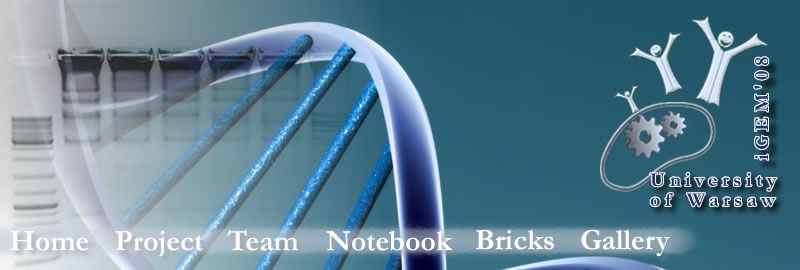Team:Warsaw/Calendar-Main/13 May 2008
From 2008.igem.org
(Difference between revisions)
MKrzyszton (Talk | contribs) |
MKrzyszton (Talk | contribs) |
||
| Line 1: | Line 1: | ||
{{WarNotebook}} | {{WarNotebook}} | ||
| - | <html><h3>Preparation of <a href=https://2008.igem.org/Wiki/Team:Warsaw/vectors/pMPM-T5-AID>pMPMT5+AID</a> construct | + | <html><h3>Preparation of <a href=https://2008.igem.org/Wiki/Team:Warsaw/vectors/pMPM-T5-AID>pMPMT5+AID</a> construct</h3> |
<h4>Michał K.</h4> | <h4>Michał K.</h4> | ||
Latest revision as of 13:50, 26 October 2008
 |
|||||||||
Preparation of pMPMT5+AID constructMichał K.Setup of separate cultures from colonies of transformants pMPMT5+AID (liquid LB+tetracycline). Preparation of pMPMT5-AID+T7 and pMPMT5+AID-T7Michał K.
 Fig. 1. Gradient PCR products for AID: Fig. 1. Gradient PCR products for AID:1 -DNA ladder; 2 to 13 -PCR products: In lane 2 is product of PCR reaction with annealing temperature 62°C (the lowest temperature of gradient), in lane 13 is product of PCR reaction with annealing temperature 82°C (the highest temperature of gradient). The lanes between them contain products of PCR with middle annealing temperatures.  Fig. 2. Gradient PCR products: upper - for transcriptional fusion, lower - for translational fusion; 1-DNA ladder; 2 to 12-PCR products-border annealing temperatures of gradient: 62°C (lane 2) to 82°C (lane 12)
Fig. 2. Gradient PCR products: upper - for transcriptional fusion, lower - for translational fusion; 1-DNA ladder; 2 to 12-PCR products-border annealing temperatures of gradient: 62°C (lane 2) to 82°C (lane 12)
 Fig. 3. Gradient PCR products for negative control (Top10 genomic DNA): 1-DNA ladder; 2 to 6-PCR products-border annealing temperatures of gradient: 62°C (lane 2) to 82°C (lane 6).
Fig. 3. Gradient PCR products for negative control (Top10 genomic DNA): 1-DNA ladder; 2 to 6-PCR products-border annealing temperatures of gradient: 62°C (lane 2) to 82°C (lane 6).
|
 "
"





